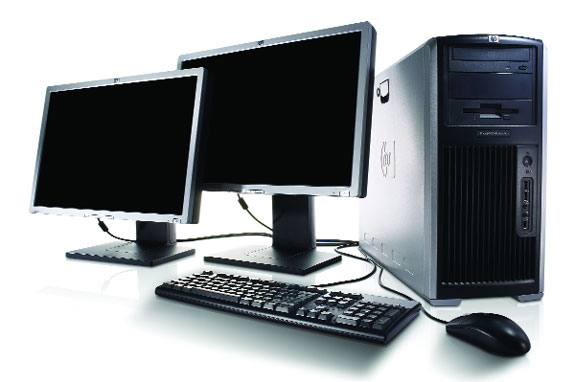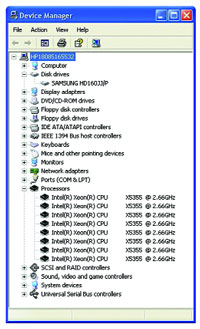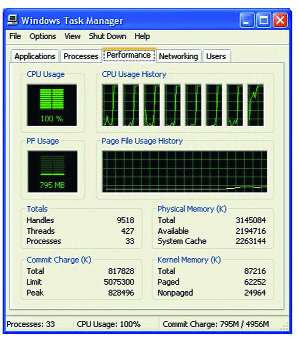Four on the Floor
HP updates the xw8400 workstation with Intel's new Clovertown quad-core CPU.
Latest News
December 4, 2001
By David Cohn

The HP xw8400 workstation is now available with one or two quad-core Intel Xeon 5300
series processors.
The first quad-core-equipped workstation to arrive at Desktop Engineering is the HP xw8400. We previously reviewed this computer last summer (see “Xeon Takes Off” in the August 2006 issue of DE). That first system was equipped with a pair of Intel 5160 “Woodcrest” processors running at 3.0GHz, with 2GB of memory, a NVIDIA Quadro FX 3500 graphics accelerator, and two hard drives (including a 15,000rpm SAS drive).
Other than those differences, the two systems are nearly identical, housed in the same case, based on the same motherboard, and sporting the same ports on the front and rear panels. (Please refer to our earlier review for a complete description of the system details.)
Intel’s new Kentsfield and Clovertown processors are each really more like two dual-core Woodcrest processors combined into one chip, much like Intel’s original dual-core Pentium D “Smithfield,” which was two “Prescott” CPUs in a single package (see “The Dual-Core Promise” in the October 2005 issue of DE for our initial take on that first dual-core CPU). The Clovertown CPUs use Intel’s newer Core Micro-architecture, enabling Wide Dynamic Execution, Intelligent Power Capabilities, Advanced Smart Cache, and Advanced Digital Media Boost. All 5300 series CPUs are based on the same 65 nanometer (nm) fabrication process as the 5100 series. With two processors installed in our evaluation system, both Device Manager and Windows Task Manager indicated a total of eight CPUs.
 |  |
| With two quad-core processors installed, both Device Manager and Windows Task Manager indicated a total of eight CPUs. During our new multithreaded AutoCAD rendering benchmark, CPU usage reached 100% and all eight cores were active. | |
The reasoning behind the move to multiple cores is not hard to understand. For years, the way to get more performance out of a CPU was to increase its clock speed. But as the chips reached 3GHz and the number of transistors inside those chips continued to increase, the power requirements of the CPU and the heat generated made the chips less and less efficient. The way around this is to move to parallel processing.
More Cores to Come
There are five members in the 5300 series, with CPU speeds ranging from 1.60GHz to 2.66GHz. All but the fastest processor consume 80 watts, with the 5355 using 120 watts. The 1.60GHz 5310 and 1.86GHz 5320 use a 1066MHz front-side bus, while the 2.0GHz 5335, 2.33GHz 5345, and 2.66GHz 5355 use the faster 1333MHz bus speed. The 5300 processors are available in the newest iterations of the dual-socketed HP xw6400 and xw8400 workstations.
The Kentsfield processor, now known as the Intel Core 2 Extreme QX6700, is available in the single CPU-based HP xw4400 workstation. But that 2.66GHz processor is priced the same as Intel’s earlier Core 2 Extreme chip, the 2.93GHz dual-core X6800.
|
|
In the meantime, AMD currently offers a platform called Quad FX, but it actually uses two dual-core processors in separate sockets. Later this year, AMD will release its first true quad-core CPUs, Altair for desktops and Deerhound for workstations and servers. Both are based on AMD’s new 65nm “Barcelona” core architecture.
What Should You Buy?
That’s all fine, but if you’re in the market for a system right now, what should you buy? While prices for an xw8400 workstation start at $1,769 (including a single 1.60GHz dual-core Xeon 5110, 1GB of RAM, and a Quadro NVS 285 graphics board), a system with one 5160 dual-core CPU, 2GB of RAM, FX 3500 graphics board, and the DVD +/-RW optical drive would cost $4,217. Adding the second dual-core CPU and doubling the memory raises the price to $5,624. The same system with a single quad-core 5355 and 2GB of RAM would run $4,809, while a second quad-core 5355 processor and 4GB of RAM brings the total cost to $6,808.
If the applications you regularly run are already significantly multithreaded, more CPU cores will immediately equate to better performance. If, on the other hand, you’re running a current midrange CAD application, the faster dual-core CPU will probably perform better — for now. It appears clear that parallel processing is the future. It’s just not yet clear how fast we will all get there.
David Cohn is a computer consultant and technical writer based in Bellingham, WA, and has been benchmarking PCs since 1984. He’s a contributing editor to DE, an applications engineer with The PPI Group, the former editor-in-chief of Engineering Automation Report and CADCAMNet and the author of more than a dozen books. Please send comments about this article here. You can also contact David at [email protected] or visit his website at dscohn.com.
Subscribe to our FREE magazine, FREE email newsletters or both!
Latest News
About the Author
David Cohn is a consultant and technical writer based in Bellingham, WA, and has been benchmarking PCs since 1984. He is a Contributing Editor to Digital Engineering, the former senior content manager at 4D Technologies, and the author of more than a dozen books. Email at [email protected] or visit his website at www.dscohn.com.
Follow DE





